Appalachian Trail hiker Geraldine Largay set off around 7 a.m. Monday, July 22, 2013, walking north on a 9-mile journey toward the Spaulding lean-to, with plans to camp there overnight. She planned to hike another 13 miles the next day to meet her husband, George, where the trail crossed Route 27.
A few hours into the hike as the temperature climbed to near 70 degrees, Largay walked off the trail to relieve herself. The 66-year-old woman from Tennessee soon realized she was lost and couldn’t find her way back to the trail.
Around 11 a.m., she took out her blue Samsung sliding phone and texted her husband: “In somm trouble. Got off trail to go to br. Now lost. Can u call AMC to c if a trail maintainer can help me. Somewhere north of woods road. Xox.”
But the message wouldn’t transmit because there was no cell coverage in the area. She tried sending the text 10 more times over the next hour and a half.
Largay walked west through the dense and vast woods of northern Franklin County, seeking higher elevation in the hopes of getting a cellphone signal.
The next day, Tuesday, she tried texting her husband again, at 4:18 p.m.: “Lost since yesterday. Off trail 3 or 4 miles. Call police for what to do pls. Xox.” She tried sending it again 20 minutes later. Still nothing.
Largay decided her best chance of survival would be to stay put. She set up a tent on a bed of pine needles and sticks and would write in a journal every day for at least the next 18 days. A final entry was dated Aug. 18 — 26 days after she set up camp — but it’s not clear whether the date is correct.
In an Aug. 6 journal entry, Largay wrote, “When you find my body, please call my husband George and my daughter Kerry. It will be the greatest kindness for them to know that I am dead and where you found me — no matter how many years from now. Please find it in your heart to mail the contents of this bag to one of them.” That entry was about a week after the Maine Warden Service scaled down search efforts.
Largay’s remains and her campsite were found more than two years later.
The Warde Service detailed the conclusions about her last days and evidence in a Nov. 12, 2015 report, that is among a 1,579-page case file obtained Wednesday by the Morning Sentinel. The report makes clear that authorities believe Largay survived alone in the woods for weeks as a massive search and rescue effort scoured the vast area in vain.
Largay kept the journal and her cellphone in a bag that was recovered by the warden service after a contractor happened upon her campsite in October 2015 and led investigators to the scene on Oct. 15. The warden service’s case file, which was first reported Wednesday by The Boston Globe, contains hundreds of pages of evidence photographs, witness interviews and tips.
The warden service had not previously disclosed a journal had been found at Largay’s campsite, and officials had not said how long Largay may have survived after going off the trail.
Warden Service spokesman Cpl. John MacDonald declined to comment Wednesday when asked about the report and its contents.
David Fox, a friend of the Largay family who has previously acted as a spokesman, did not return a call seeking comment Wednesday.
SINGLE CLUE
Largay was a thru-hiker on the 2,184 mile Appalachian Trail, which starts at Springer Mountain in Georgia and ends at Mount Katahdin in Maine. She had started on the trail in West Virginia in April with a friend, Jane Lee. Lee did not respond to an email seeking comment Wednesday.
Largay’s husband of 42 years, George, told police that the trail was on his wife’s “bucket list” and that he had supported the women along the way, meeting them and taking them to motels to sleep, do their laundry and shower.
He and Largay had arranged to meet where the trail crossed Route 27 in Wyman Township on July 23.
By 11 a.m. the morning of July 22, Largay had attempted to send him the text message telling him she was lost, according to a cellphone examination by the Maine Computer Crime Lab completed Oct. 20.
George Largay reported her missing on July 24 after she didn’t arrive at the meeting spot. That was two days after she was last seen by other hikers in the early morning of July 22, at the Poplar Ridge lean-to.
Largay died in her sleeping bag inside a zipped tent, according to a report from the chief medical examiner, released in January. She died from a lack of food and water and environmental exposure, according to the medical report.
She was about two miles from the Appalachian Trail, on land belonging to the U.S. Navy. The warden service, volunteer groups, police and others looked for Largay over 26 months, and the search is considered one of the most lengthy and expensive in state history.
“Investigation would take time to work through several false leads, false identifications, and locating and finding hikers who had valuable information and continued to hike the trail,” Lt. Kevin Adam of the warden service wrote in his report filed Nov. 12, 2015.
A dog search crew came within 100 yards of where Largay’s remains eventually were found three times during the course of the search, Adam said at an October news conference following the discovery of her remains.
After seven days of intense searching, the effort was suspended on July 30, 2013, though periodic efforts continued over the coming months.
A photo taken of Largay at the Poplar Ridge lean-to by another hiker was the single clue that investigators found that could be attributed to her case.
“There were many leads over the next 26 months, ranging from persons of interest for possible criminal activity related to Gerry’s disappearance, identity theft involving Gerry’s personal information, geographic information by psychics, sightings in different states, to information suggesting Bigfoot was responsible for her disappearance,” Adam wrote in his report. “All of these leads were investigated with our investigative partners.”
A forester working on a contract for the U.S. Navy came across Largay’s tent site and remains on Oct. 11, 2015, and wardens reached the site four days later.
HIKING CONCERNS
Interviews included in the warden service’s case file raise questions about how prepared Largay was to complete the hike, especially after her friend left the trail because of a family emergency, leaving Largay to continue on alone.
In the aftermath of her disappearance, family and friends of Largay described her as an experienced hiker who, if she became lost, would have used common sense to find her way out.
She was a meticulous planner who always knew where to find water and suitable shelter, and she was careful when crossing streams to always look for the safest route, according to an account of an interview with Lee in the warden case file. She took medication for asthma and blood pressure, but a doctor who evaluated her before her departure on the hike said she was in good health.
But Lee, who described herself as Largay’s best friend, also told the wardens about multiple occasions when she had to backtrack on the trail to find her hiking companion. In those cases, Largay had either become lost or had fallen behind, Lee told investigators.
On one occasion, Largay relied on another hiker to get her headed in the right direction, according to the interviews described in the case file. The incidents were becoming more common as the pair continued, the weather got warmer and the terrain became more difficult, according to Lee’s account.
Largay’s doctor was concerned that she may have not been taking a prescribed anti-anxiety medication, which would have made her susceptible to panic attacks. The medication was not found among Largay’s belongings and Lee, a nurse, said she was not aware of it, even though the two had gone over their prescriptions together in case of an emergency.
Largay had a poor sense of direction and when she made a mistake would become easily flustered, according to the warden case file. Her friend also described her as scared of the dark, scared of being alone and said she never wanted to bring extra supplies because she had a sore back and wanted to avoid having a heavy pack.
Lee told the wardens that she didn’t know if Largay’s husband was aware of his wife’s struggles, but George Largay also told investigators that “Gerry was probably in over her head trying to go the hike.”
Wardens believe Largay reached the location where she set up camp on July 23, according to an investigative summary included in the case file. She set up her tent on a bed of pine needles and sticks and wrote in her journal every day for more than two weeks.
The final entry was dated Aug. 18 — more than three weeks after she was reported missing — but Adam wrote in his report, “we are unsure if this is a correct date or not.”
Adam also recounted when investigators on Oct. 15 came across the final words written by Largay inside the tent.
“Some of the passages were read, and we realized she marked in her book passages up to August 6,” he wrote. “I realized from listening to the passages being read that there were a lot of personal letters and compositions to family members inside the book. I asked the officer to stop reading and we would analyze it all later when we had more time.”
On Oct. 18, Adam and other game wardens met with George and other family members to show them where Largay was found. They hiked through thick softwood trees along the Appalachian Trail, into more open terrain with hardwoods, past old logging roads, down and up steep ridges and over brooks. Then, they arrived.
“After everyone finished looking around the campsite, the family left a cross where the tent was located along with several family mementos,” Adam wrote. “After clearing the campsite, we headed south.”
Rachel Ohm — 612-2368
Twitter: @rachel_ohm
Copy the Story LinkSend questions/comments to the editors.


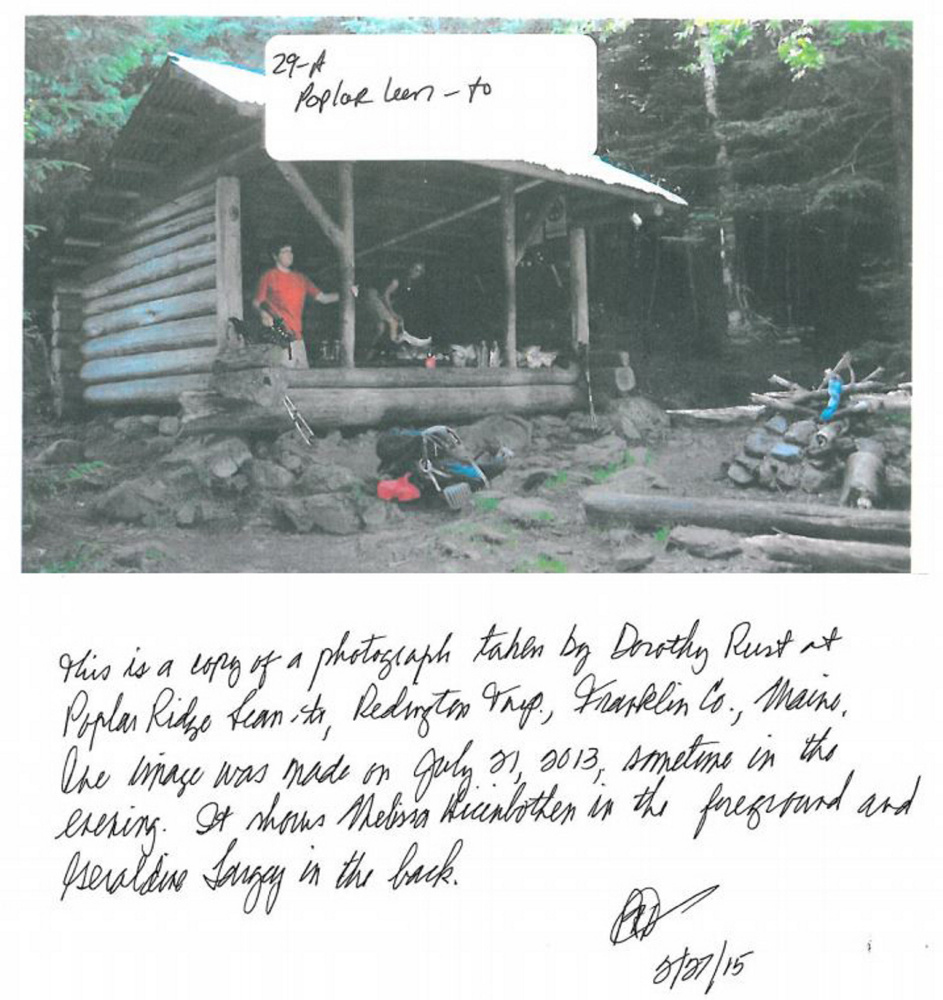
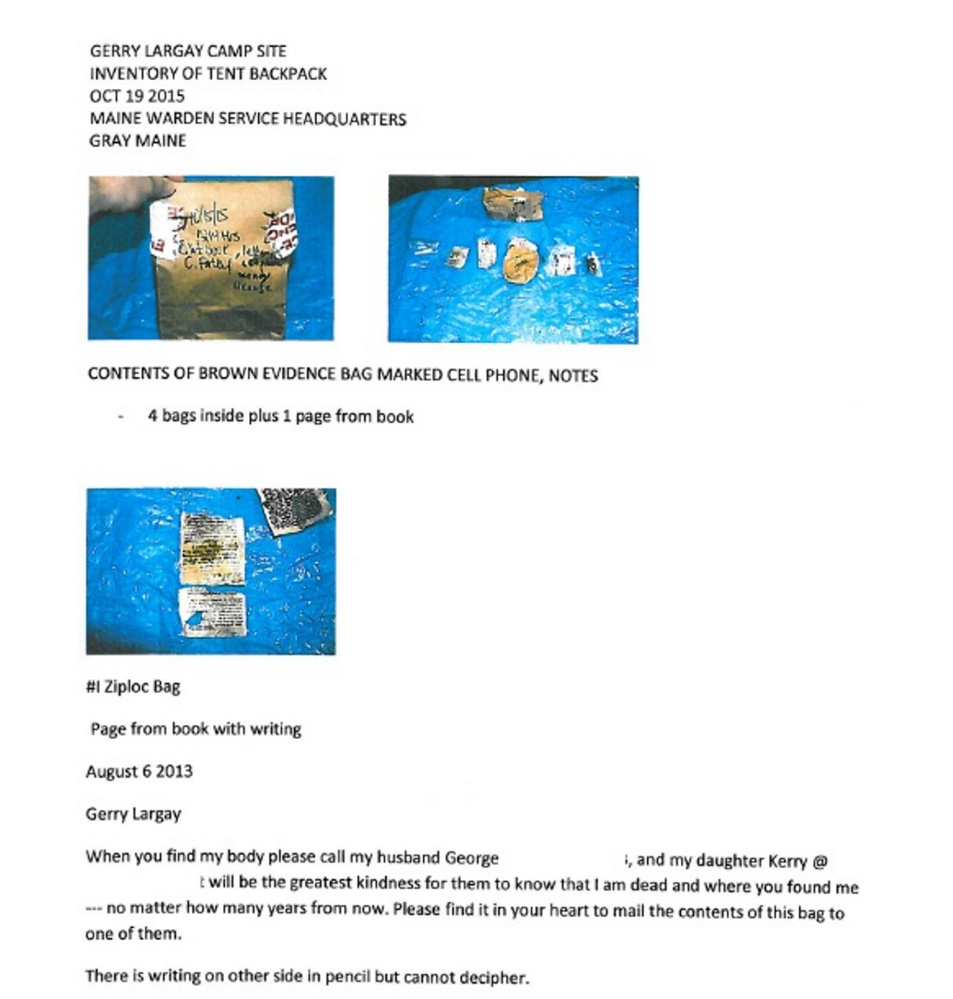

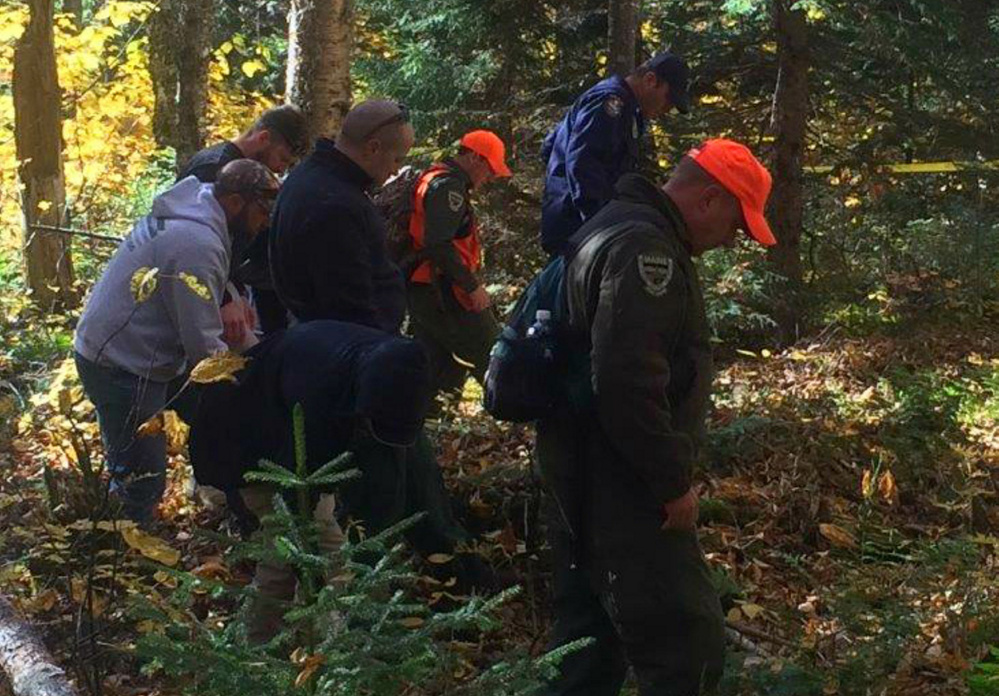
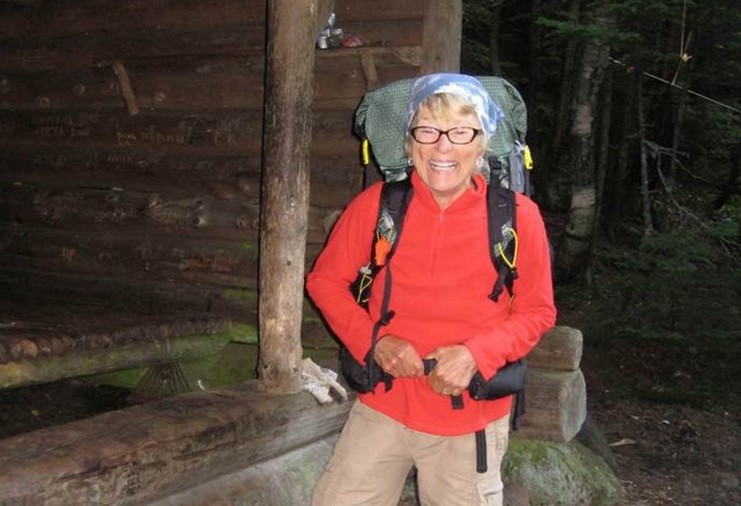
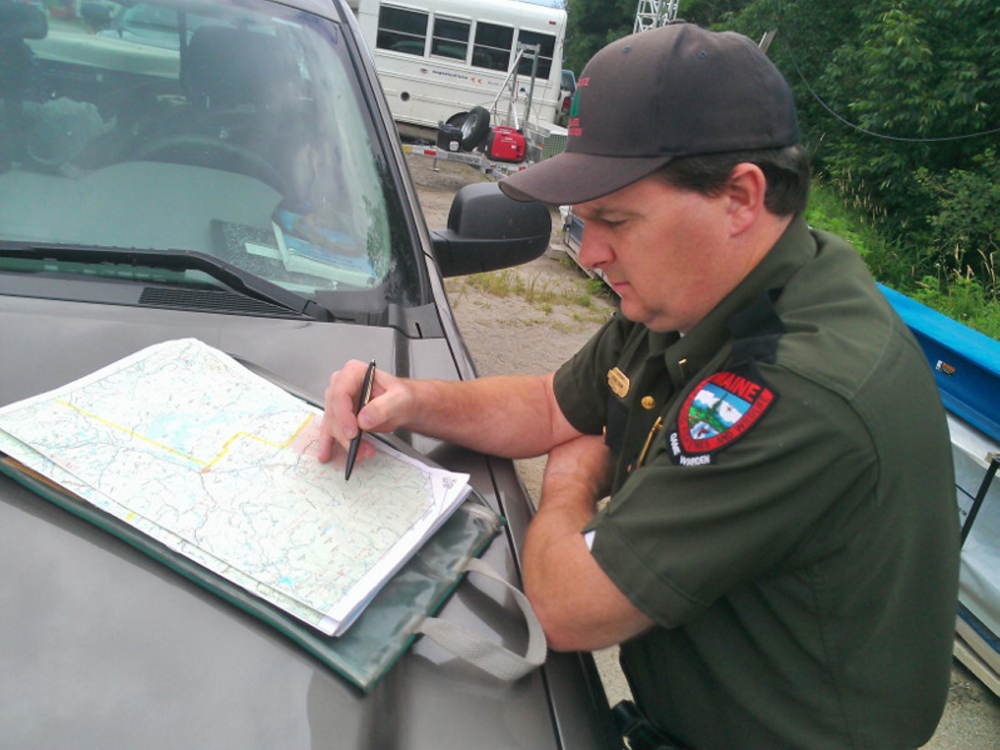
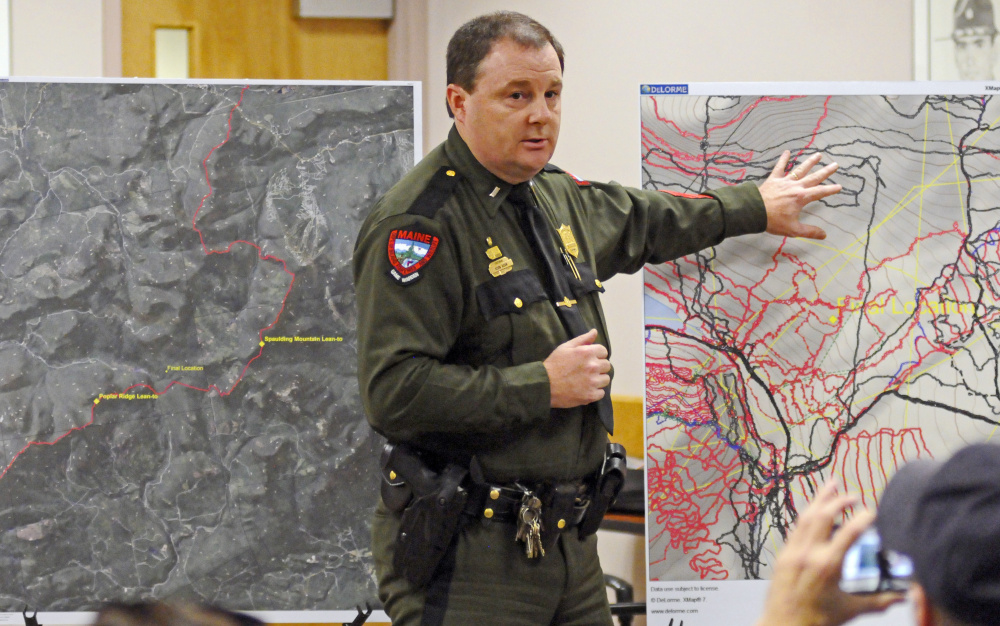
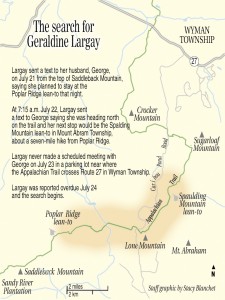
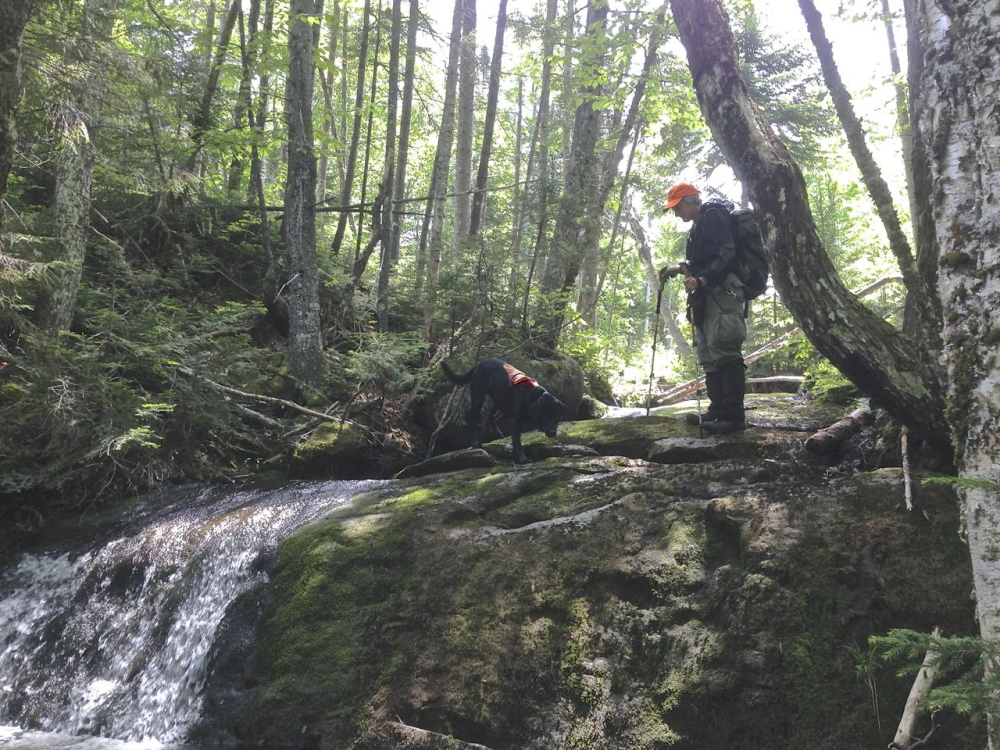




Success. Please wait for the page to reload. If the page does not reload within 5 seconds, please refresh the page.
Enter your email and password to access comments.
Hi, to comment on stories you must . This profile is in addition to your subscription and website login.
Already have a commenting profile? .
Invalid username/password.
Please check your email to confirm and complete your registration.
Only subscribers are eligible to post comments. Please subscribe or login first for digital access. Here’s why.
Use the form below to reset your password. When you've submitted your account email, we will send an email with a reset code.